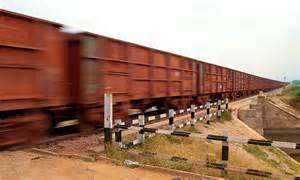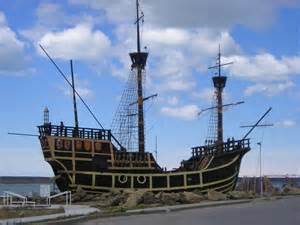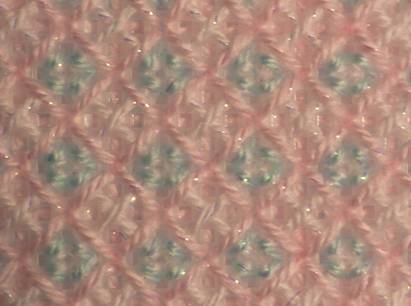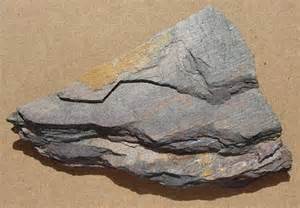
Salty Sam’s Fun Blog for Children
Number 140
The History of Railways
Hello Everyone

Bill and Bob were playing with their model railway this week.
They were assembling some models to put on it and caused quite a disruption in the kitchen with freshly-glued and painted models drying all over the place.
When the real railways came to Britain they had a huge impact as well.
lt is hard to believe now, but before railways came along most people had never travelled more than a few miles away from the place where they were born for the whole of their lives!
Only those with money or those in the military who went to foreign battlefields travelled long distances.
The first train was built and sometimes driven by George Stephenson. lt was called Rocket and first ran on a track built between Stockton and Darlington on 27th September 1825. The train only went at 13½ miles and hour and yet it is said that some people fainted with fear at the speed!
Before the railways, a journey between London and Edinburgh took five days by horse or horse-drawn coach. By train it took 12 hours.
The railways created a network of speedy communication that had never been seen before in human history. Five thousand miles of track was laid in just ten years.
lt was very important for the economy because in those days Britain was developing rapidly in the lndustrial Revolution. lt imported cotton from America through docks like Liverpool and changed it into fabric in the factories in the north in places like Manchester.
So goods needed to be transported quickly and efficiently – and railways enabled people to travel as well.
lt changed the life of ordinary people in so many ways.
Goods like food and building materials could be transported easily and some of these things became available to parts of the country for the first time.
Newspapers could be transported from London all over the country within a day, thus spreading information more rapidly than ever before. And letters between friends and businesses were carried by trains too.
People went on day trips to the seaside. lf they lived in London for example, they could go to places like Brighton and Southend for a day out. Eventually, people would have holidays by the sea and seaside towns became the new holiday destinations rather than the spa towns.
(A spa was a place where there was a natural spring of water. People thought it was good for their health to drink this water and bathe in it – a modern spa is a little bit different but people still go there to relax.)
Paddle steamers were powered by steam engines too. They took people on river trips and trips across the sea.
But the most unbelievable thing is that clocks showed different time in different in different parts of the country.
What is more, hours were different lengths according to what season it was. The day time was divided into the same number of hours no matter how long it was. Of course the day was longer in the summer and shorter in the winter and clocks were adjusted accordingly to make ‘hours’ longer or shorter.
Time had to be standardized in order to make the railway timetables work.
‘Railway time’ was invented.
The mechanical clockwork clock was invented in a 13th century monastery. lt told the monks when it was time for prayers and calling them to prayers happened several times a day.
At this time, the days and nights were each divided into 12 equal ‘hours’. Because the days were longer in the summer and shorter in the winter the length of the ‘hours’ altered through the year.
The lengths of the ‘hours’ had to be changed in the clocks. This was done by moving weights up and down a bar that was attached to the clock mechanism. ln this way, the monks could keep track of the time.
The use of clocks spread throughout monasteries across Europe and then clocks were put into church towers.
Other people in society did not need to measure time so accurately because their lives were not as disciplined as the lives of the monks. The laity (people who didn’t work in the church) largely worked on the land and lived their lives with the rhythms of nature.
They worked outside a lot in the spring, summer and autumn (sowing and harvesting) but stayed inside more in the winter when the weather was colder, the nights were longer and there wasn’t so much work to do outside in the fields.
When railway time was invented, the measurement of time was reinvented by people who were focussed on technology, business and commerce rather than religion and prayer.
Even today, railways are important to us. One billion people travel on them every year, sometimes they are commuters going to work and sometimes they are travellers visiting family, or they are people going on holiday.
And of course, there are railways all over the world. The longest being the Trans-Siberian Railway running 5,865 miles from Moscow to Nakhodka on the east coast. lt takes eight days to do the journey – which seems a long time until you realize that the journey had been known to take two years before the railway was built!
Trains can be long too. ln 1968 a coal train travelled between West Virginia and Ohio – it was just over 4 miles long. The 500 wagons needed three engines at the front and three at the back to move the load. ln 1989, an even longer one travelled through South Africa with 660 wagons and 16 engines incorporated along the length. ln Australia in 2001, a 682 wagon-train controlled by a single driver beat that record.
The fastest steam train was the Mallard which reached 126 mph in 1938, and the fastest train today in France can travel at 320 mph – although its usual speed is around 130 mph. The scenery going just past the window must be a blur!
The world is ‘getting smaller’. lt took Magellan sailing in an old sailing ship nearly three years to go around the world and now a satellite takes just over an hour.
Bye bye everyone – don’t forget to subscribe to my blog!
lf you like my blog, please support it by telling all your friends and followers about it.
Thank you!
And see you again next Fun Friday!
Love and kisses
Salty Sam

www.christina-sinclair.com


Bill and Bob’s Joke of the Week![]()
![]()
Bob: Why is a puppy like a steam train?
Bill: l don’t know. Why is a puppy like a steam train?
Bob: Because it chew chews all day long!

Salty Sam © Christina Sinclair 2015
Unauthorized use and/or duplication of material from this blog without express and written permission from this blog’s author and owner is strictly prohibited.
Links may be used to www.christina-sinclair.com

Picture Gallery

Stephenson’s Rocket 1829

Victorians also had buckets and spades on the beach ![]()

Newspapers could be sent all over the country
News had never spread so fast

The Mallard is one of the most famous steam trains

Goods trains in some parts of the world can be over a mile long

A Japanese train that goes at 217 MPH

Magellan’s ship

A model of a paddle steamer – the paddles were at the side and the chimney from the engine, this was called a funnel, was in the middle and there were plenty of seats for people sit on

Steam engines and steam boats had funnels (which are in effect chimneys)

London Chatham and Dover Railway Station at Blackfriars
Illustrated London News 26th December 1863

The famous bridge is no longer

Undisturbed triangles and strips of land between railway lines are useful for giving shelter to wildlife

The third rail on British railways is electrified – touching it will kill you if you are in contact with the ground
The third rail is the rail furthest from a railway platform

Have you ever wondered why there are doorways by the side of the tracks that go nowhere?
It is because they are actually places for railway workers to stand when a train passes by

Steam trains regularly ran on our railways until the 1960s

The train carriages were made from wood

The compartments were often enclosed

There were third-class carriages

There were ladies-only compartments and the luggage racks were made with string-like nets

The railway maps looked different too

A modern day diesel goods train

The train emblem

The train is pulling 18 trucks of sand

Modern trains are controlled by computer and don’t need drivers anymore
You can sit in the front seat and pretend you are the driver ![]()


 THE SALTY SAM NEWS DESK
THE SALTY SAM NEWS DESK

A couple of weeks ago, Auntie Emily made a nightdress for Emily’s doll and Emily was getting a little concerned that her doll might get cold on a chilly night so Auntie Emily has now made a dressing gown to go with it.

The pattern for it is here, but if you feel that moss stitch is too difficult for you, then it will work in garter stitch as well.
NEWSDESK MINIMAKE
A 12” DOLL DRESSING GOWN
DRESSING GOWN BACK (KNIT ONE)
Using 3¼mm knitting needles and white 4ply yarn cast on 24 stitches
Knit 1 row, knit 1 row
(K1 p1) repeat last 2 stitches to end
(P1 k1) repeat last 2 stitches to end
Repeat last 2 rows 49 times (100 rows of moss stitch)
Cast off
FRONTS (KNIT TWO)
Cast on 16 stitches
Knit 1 row, knit 1 row
(K1 p1) repeat last 2 stitches to end
(P1 k1) repeat last 2 stitches to end
Repeat last 2 rows 49 times (100 rows of moss stitch)
Cast off
SLEEVES (KNIT TWO)
Cast on 16 stitches
Garter stitch 6 rows (for cuff)
(K1 p1) repeat last 2 stitches to end
(P1 k1) repeat last 2 stitches to end
Repeat last 2 rows 14 times (30 rows of moss stitch)
Cast off
TO MAKE UP
- With right sides facing sew 1cm/½ inch up shoulders using over-sew stitches.
- Turn the pieces right side out.
- Fold the fronts back in half and attach the lapels to the shoulder line along the tops.
- The inner points should be attached to the outer sides of the shoulders.
- With right sides facing again use over-sew stitches to sew garment together.
- Attach the tops of the sleeves to the shoulders.
- Sew up under arm and side seams.
WAIST CORD
- Wrap a length of yarn around a 30cm ruler 14 times.
- Using the yarn double crochet 95 chain stitches.
- Put a knot into each end and pull the ends into the chains.



*********************
TO ADVERTISE ON THIS BLOG
PLEASE CONTACT:
christina.sinclair.ads@aol.co.uk
*********************


Quick Quiz
What is the difference between these words?
- stationary/stationery
- slate/tile
- warp/weft
- continually/continuously
- What does ‘to be out on the tiles’ mean?


BLOW MY FOGHORN!!!

PLUS
Salty Sam fans can join in with their comments and share them with children all over the world. You will need to ask permission if you are not an adult.
Enter your e-mail address to subscribe to my blog and receive new Salty Sam Blog Posts for free by e-mail every week. Your address will be kept private and will not be shared with any third party.
Sign me up at the side bar




lt’s the Weekend!

HOW TO MAKE A WRlTlNG PAPER HOLDER
If you ever want to send someone a thank you note or a short letter, you might use notelets or postcards, or if you collect birthday cards well before birthdays, this is a handy storage box to keep them in.
![]()
![]()
![]()
- Select a thin cardboard box to use as an inner skin.
- Cut the panels of plastic canvas at least one row of holes larger width-ways than the size of your box.
- Make sure that the number of holes will accommodate the type of canvas work stitch you wish to use.
You will need 5 panels of plastic canvas:-
The holder in the photograph below is made from:
2 pieces of canvas 51 holes by 28 holes
2 pieces of canvas 28 holes by 17 holes
1 piece of canvas 51 holes by 17 holes – keep this empty
The canvas work stitch is called Rice Stitch – for the instructions on how to do it look at the grids below (this pattern is worked over a grid of five by five squares).
Bring your needle up on the odd numbers and down on the even.
Work across the canvas using white yarn making crosses across a box of 5 by 5 holes.
|
2 down |
3 up |
|||
|
4 down |
1 up |
(5×5 squares on your canvas – work from each corner)
Cover the white crosses with pink crosses and create crosses at the back as you go to cover the holes from behind.
|
5 and 8 |
||||
|
1 and 7 |
3 and 6 |
|||
|
2 and 4 |
(5×5 squares on your canvas – work from each centre square on each side)
Stitch turquoise crosses over the corners just inside the pink stitches. Make sure that the top strand is always facing the same way to keep the appearance even.
Stitch a border around the panels using white then pink.
To construct the box sew the sides to the base then sew up the four corners using over-sew stitching in white yarn.
Over-sew the top rim in pink.
If the inner box doesn’t quite fit the outer embroidered box there might be room to keep a pen – but don’t let it leak over your work!




Please note that the material on this blog is for personal use and for use in classrooms only.
It is a copyright infringement and, therefore, illegal under international law to sell items made with these patterns.
Use of the toys and projects is at your own risk.
©Christina Sinclair Designs 2015


Quick Quiz Answers
- stationary/stationery
- slate/tile
- warp/weft
- continually/continuously
- What does ‘to be out on the tiles’ mean?
- not moving – like a train at a station/writing materials like paper and pens
- quarried (dug up from the ground)/man-made in a furnace
- vertical threads in a cloth/horizontal threads in a cloth
- happens very frequently/doesn’t stop at all (like an evacuation bell)
- To have fun at a party at night

How fabric is woven

Slate from the ground

Slates on a roof

Mail trains didn’t stop at stations. They picked up mail sacks with a bar sticking out from the train
and threw bags of mail to be delivered in that vicinity into a net that was waiting on the platform.
![]()



Great blog here! great article
Thank you!
Hello
How do you start at the beginning of your blogs like the 1st one thank-you
Hello Pauline
l am not sure that l understand exactly what you are asking me.
This blog is built on a WordPress platform.
ls that what you meant?